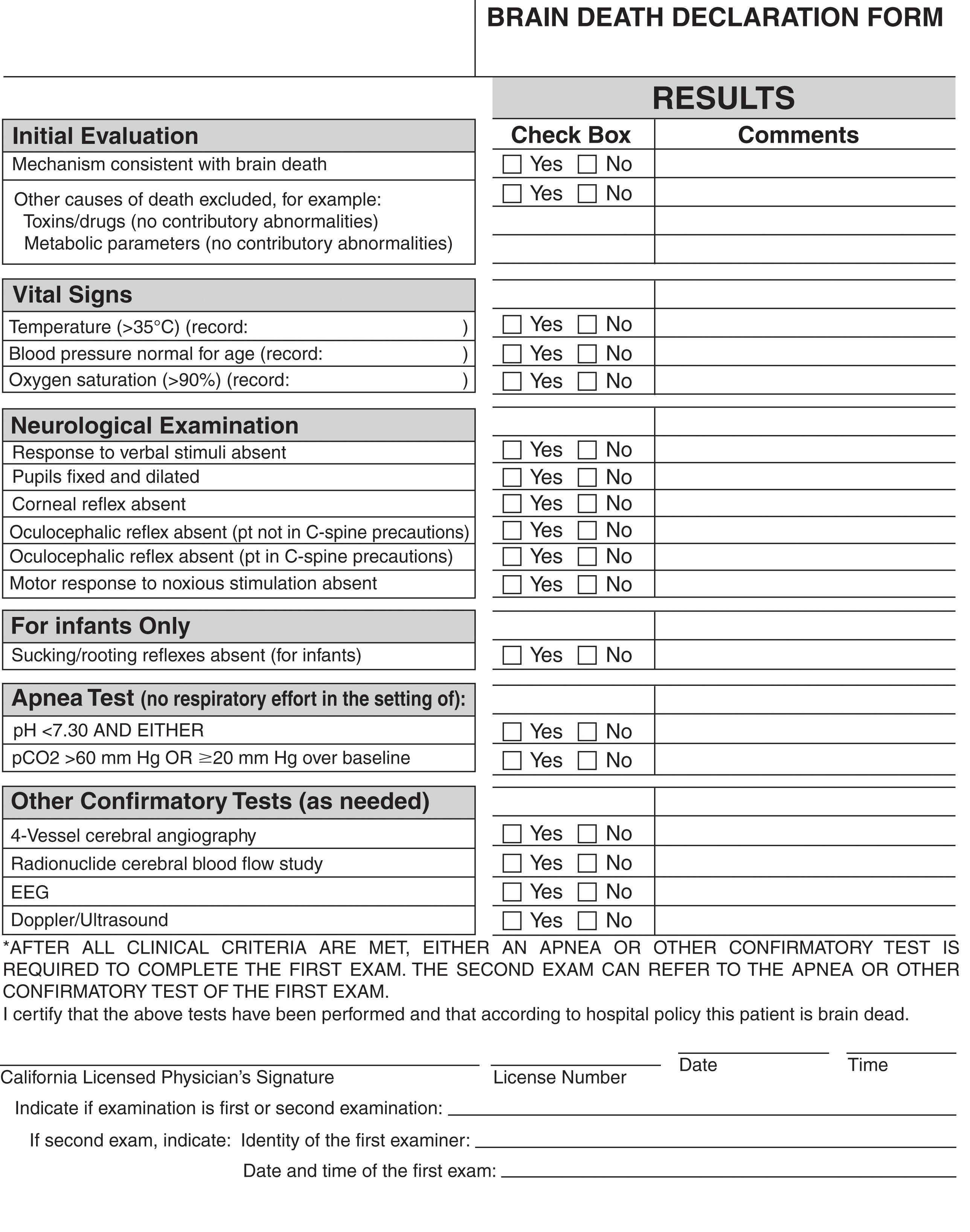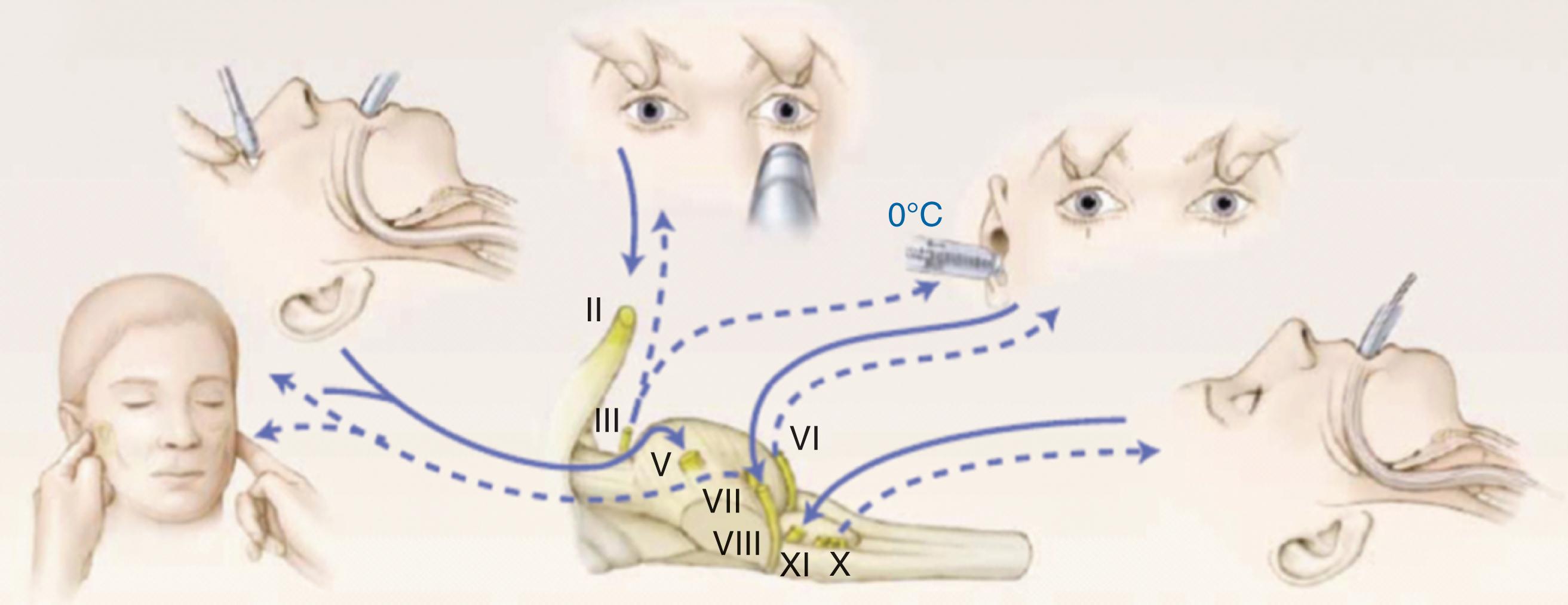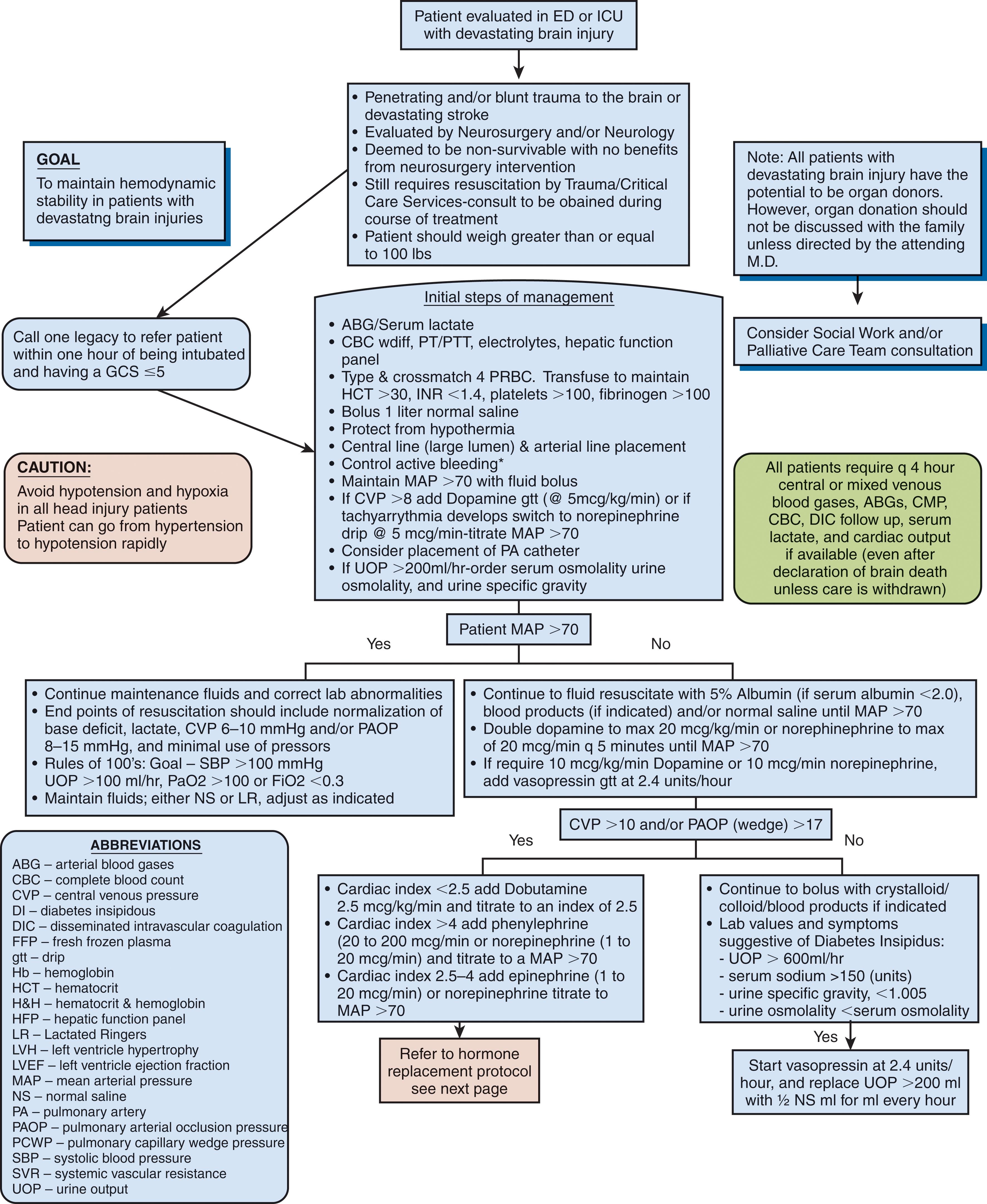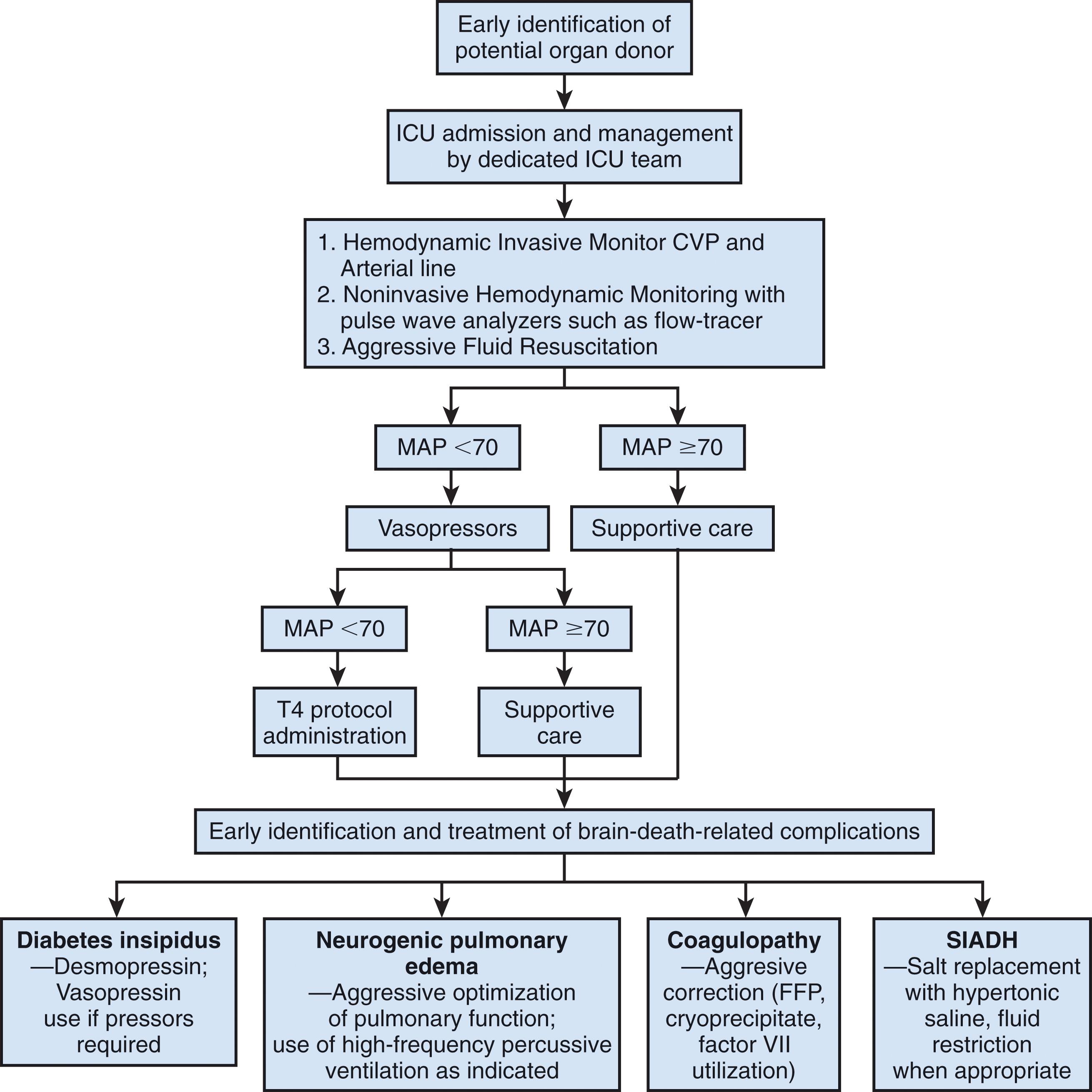Physical Address
304 North Cardinal St.
Dorchester Center, MA 02124
Some neurologic injuries are so severe that they are initially deemed to be nonsurvivable and are termed “catastrophic brain injuries.” In such cases, the primary goal of critical care is to maintain hemodynamic stability and end-organ perfusion. The primary reason for maintaining normal physiologic parameters is that some initial prognostications are incorrect and maintenance of optimal critical care and perfusion of the brain may allow for some patients to improve and survive. For those that do not improve and regress to brain death (BD), the goal shifts to preserving the option of organ donation for every patient and family that choose to pursue it. In this chapter, we will review the diagnosis of BD as well as the physiologic response to brain stem herniation and the care of patients with catastrophic brain injuries.
Throughout its history, the concept of BD has caused great controversy in medicine and politics. Its nature and finality have been topics of debate among ethicists, law professors, government agencies, and health care workers. First introduced by Mollaret and Goulon in 1959, BD was originally described as a persistent vegetative state or permanent coma. The definition of BD evolved until 1968, when the Harvard Medical School ad hoc Committee created the current definition; this definition was affirmed by the Uniform Determination of Death Act in 1981.
As it is currently defined, BD death is the loss of all brain function. This function is controlled by the brain stem, which is also responsible for breathing and heart rate. Brain stem reflexes, surrogates for brain stem activity, can be evaluated through testing the ability to gag or cough when the airway is obstructed, the withdrawal from pain, and pupillary function. Without a functioning brain stem, life cannot exist. Therefore, diagnosing BD requires the absence of brain stem function.
The American Academy of Neurology has published evidence-based guidelines on determining BD, which is a complex process involving a comprehensive clinical examination, excluding confounding factors, and performing an apnea test. Many centers have adopted checklists to protocolize this determination, as it can involve upwards of 25 individual assessments. These protocols ensure confidence in the determination of BD prior to initiation of the authorization process for organ donation. The Neurocritical Care Society recommends a 72-hour care period after brain injury to determine prognosis prior to discussions regarding poor prognosis and withdrawal of life-sustaining treatments. If, however, all brain stem reflexes are lost and BD is suspected, formal testing can and should occur at any time.
To establish a diagnosis of BD, the clinician must first identify the underlying causes of coma and determine that they are irreversible. Trauma, stroke, cerebral hypoxia, intracranial hemorrhage, tumors, meningitis, and encephalitis are all well known underlying causes of catastrophic brain injury and BD. To ensure the certainty of the BD diagnosis, any confounding reversible factors must be eliminated, such as hypothermia (less than 35° C), hypoxia, intoxication by legal or illegal drugs, shock/hypotension, and severe electrolyte disturbances. Figure 1 contains an example of a BD declaration form. The clinical BD assessment is usually made in the intensive care unit (ICU) and typically involves three steps: verification of unconsciousness, documentation of absent brain stem reflexes, and performance of the apnea test. An overview of the procedure and an example of a BD declaration protocol can be found in Table 1 and Figure 1 , respectively. For the purposes of BD determination, unconsciousness is defined as a Glasgow Coma Scale score of 3(T) and is determined via clinical examination in the absence of any sedation or other confounding factors as described previously. The five brain stem reflexes that should be assessed in adults are shown in Figure 2 . If all brain stem reflexes are absent, the final clinical BD assessment, the apnea test, is performed.

|

Prior to initiating the apnea test, the patient should have a Pco 2 within the normal range and be preoxygenated with 100% Fio 2 . The patient is then disconnected from the ventilator and closely monitored for any evidence of respiratory effort. Criteria for a positive apnea test (diagnostic of BD) are as follows: no attempt to breathe while disconnected from the ventilator (as oxygen is still delivered to the airway), a Pco 2 greater than 60 mm Hg or a rise in Pco 2 greater than 20 mm Hg above baseline, and an arterial pH less than 7.3. It usually takes 5 to 10 minutes of apnea for the Pco 2 to meet criteria; we recommend drawing arterial blood gases every 3 minutes until either BD is confirmed or the patient becomes hemodynamically unstable, at which point ventilation should be resumed. While some institutions recommend that the clinical examination (including the apnea test) be performed twice, at least 6 hours apart for adults and up to 48 hours apart for neonates, the need for a second assessment remains controversial.
If the patient is hemodynamically unstable such that the risk of cardiac arrest is thought to be high if maintained for even a few minutes off the ventilator, other confirmatory tests may be used. Historically, the most common ancillary BD study in the United States is cerebral angiography. If the carotid arteries do not fill past base of the skull and there is no blood flow within the calvarium, the patient can be declared brain-dead. Recently, clinicians have used magnetic resonance or computed tomography angiograms in lieu of more invasive traditional angiography. Electroencephalography (EEG) is also well validated and is frequently used to confirm BD; on EEG, BD is characterized by the absence of all electrical activity. The disadvantage of EEG is that devices in the ICU may cause artifacts, leading to spurious results that preclude BD diagnosis. Other tests include transcranial Doppler ultrasound to assess cerebral blood flow and nuclear imaging to assess uptake of tracer in the brain. This last method is preferred for secondary confirmation in many institutions. However, none of these confirmatory tests replace the clinical examination. Because children are more physiologically resilient than adults, a longer time between assessments has been advocated in pediatric patients. Many institutions require other confirmatory tests, in addition to the apnea test, in children less than 1 year of age.
Many institutions have differing requirements regarding who is qualified to determine BD. Some centers advocate that at least two clinicians concur on the diagnosis of BD and that at least one of those clinicians is a neurologist, neurocritical care physician, or neurosurgeon. Despite these minor institutional differences in policy, the core requirements for the declaration of BD are similar worldwide and align with the standard practice as advocated by the American Academy of Neurology.
BD can be a challenging concept to grasp for a patient’s family, and it is important to equate BD with the layperson’s understanding of bodily death, which usually means that the heart has stopped. The essential connection between brain function and conscious thought may not be obvious to laypersons and therefore should be stated explicitly when communicating the news of the patient’s death. It is imperative to separate end-of-life discussions surrounding BD and the withdrawal of medical support from conversations about organ donation to avoid any perceived conflict of interest. It is recommended that health care providers not approach family members about organ donation without first consulting with their local organ procurement agency (OPO). In general, representatives from the OPO who are formally trained to discuss organ donation with families should make the first, formal approach once end-of-life discussions have taken place and the family understands the concept of BD. Health care providers with a close relationship to the family may be involved in the process as well, but this should be carefully considered to avoid any real or perceived conflicts of interest.
The goal prior to and after the determination of BD is to maintain perfusion of vital organs. After a family authorizes organ donation, the Organ Procurement Organization (OPO) assumes care of the donor, both medically and financially, but physicians may remain involved to perform procedures and provide expert critical care advice. The brain’s central role in the body’s homeostasis is so important, that, once BD occurs, all other organ systems are affected. Preserving organs for donation is quite challenging in the face of BD, and it is not uncommon to lose donors to hormonal and cardiovascular collapse.
BD is associated with profound physiologic alterations that result in diffuse vascular regulatory disturbances and widespread cellular injury. Severe alterations in metabolism, endocrine function, immunology, and coagulopathy also commonly manifest. These disturbances frequently lead to multiorgan system failure, cardiovascular collapse, and asystole in up to 60% of patients if not appropriately managed. It is known from animal studies that this cardiovascular deterioration is associated with impaired oxygen use, a shift from aerobic to anaerobic metabolism, a depletion of glycogen and myocardial high-energy stores, and the accumulation of lactate. This irregular metabolism has been associated with hormonal changes such as low levels of triiodothyronine (T 3 ), thyroxin (T 4 ), and to a lesser extent cortisol and insulin. Therapeutic replacement with T 3 has been associated with complete reversal of anaerobic metabolism and subsequent stabilization of cardiac function when applied to brain-dead human subjects.
Recently, studies have proved that aggressive management of patients with catastrophic brain injuries who have the potential to progress to BD can improve the quantity and quality of donated organs from brain-dead donors. After a dedicated team of physicians assumed responsibility for the management of all potential organ donors at the Los Angeles County/University of Southern California Medical Center, there was an 82% increase in the number of organ donors and a 71% increase in the number of organs recovered (Salim et al. 2006). Organizing the care of the donor after brain death (DBD) into an evidence-based clinical protocol has been shown to both decrease donors lost to CVC as well as increase the number of organs procured per brain-dead donor. Given that the hemodynamic instability and endocrine dysfunction leading up to BD occurs prior to BD declaration, early management of catastrophic brain injury patients is key. Aggressive and early resuscitation of these patients, prior to BD declaration, has shown to decrease vasopressor requirements and increase organ procurement rates
Many hospitals have adopted catastrophic brain injury guidelines to assist in the management of patients with neurologic injuries and a very poor prognosis. Examples of such protocols can be found in Figures 3 and 4 . These guidelines contain standard critical care practices that would be appropriate for patients with survivable injuries and also reflect donor management protocols that many OPO personnel use. With the use of these guidelines, targeting standard critical care endpoints that are included in the donor management goals (DMGs) that many OPOs use when assuming care of an organ donor, patients who were once thought to have fatal injuries may neurologically improve. Even for patients who do progress to BD and subsequently become donors, these ICU practices that aim to improve perfusion of the brain will also, by their nature, improve perfusion of the other organs. In the end, good patient care is good organ donor care.


The checklist of DMGs that is used by the nearly 20 OPOs that participate in the UNOS DMG Registry ( https://dmginfo.nationaldmg.org/ ) at the bedside of each donor is shown in Table 2 . Although it has been found that there are more organs transplanted per donor when these goals are met by the OPO prior to organ recovery, several prospective studies have also demonstrated that having these critical care endpoints achieved in the donor hospital ICU prior to authorization for donation is associated with both more organs transplanted per donor as well as less delayed graft function (DGF) in the recipients of the kidneys from these patients. In the end, standardization of practice and optimizing the care of patients with devastating neurologic injuries has the potential to benefit these patients, as well as the recipients of their organs for those who go on to donate.
| Donor Management Goal | Parameter |
| Mean arterial pressure (mm Hg) | 60–110 |
| Central venous pressure (mm Hg) | 4–12 |
| Left ventricular ejection fraction (%) | ≥50 |
| Low dose vasopressors, n * | ≤1 |
| Arterial blood gas, pH | 7.3–7.5 |
| Pao 2 :Fio 2 Ratio | ≥300 |
| Serum sodium (mEq/L) | ≤155 |
| Urine output (mL/kg/hr over 4 hr) | ≥0.5 |
| Glucose (mg/dL) | ≤180 |
| Bundle met † | Any 7/9 |
* Low-dose vasopressors is defined as: dopamine ≤ 10 µg/kg/min, phenylephrine ≤ 1 µg/kg/min, or norepinephrine ≤ 0.2 µg/kg/min.
† Bundle met is defined as meeting any seven of the nine DMGs at any given time point.
Through the collaborative efforts of critical care providers and OPOs, consensus statements and clinical practice guidelines (CPGs) aimed at meeting DMG endpoints have been published. The following sections outline the approach to critical care management of the neurologically deceased potential organ donor. Critical care monitoring of these potential organ donors in the ICU setting should be similar to the monitoring required of most other critically ill patient populations and can be guided by general ICU practice. For management, many of these recommendations are based on the joint SCCM/ACCP/AOPO consensus guidelines published in 2015 as well as the recently published Canadian Clinical Practice Guideline for the management of the neurologically deceased organ donor. The guideline panel of experts was comprised of representatives from the Canadian Council for Donation and Transplantation(CCDT), Canadian Critical Care Society (CCCS), the Canadian Society of Transplantation (CST), the Canadian Association of Critical Care Nurses (CACCN) and the Canadian Donation and Transplantation Research Program (CDTRP).
Brain stem herniation causes disruption of the hypothalamic-pituitary axis causing loss of thermoregulation, catecholamine surges, myocardial stunning, decreased cardiac ejection fraction, hormonal loss of sodium and water regulation, and finally, a complete loss of sympathetic tone. These downstream effects of hypothalamic-pituitary axis disruption lead to massive swings in volume status, severe cardiac dysfunction, and hemodynamic instability. The labile hemodynamic status of brain stem herniation and BD should prompt close monitoring using invasive techniques such as arterial lines. Central access should be obtained for infusion of vasoactive medications, as needed; however, routine placement of pulmonary artery catheters should not be performed. Echocardiography should be used as a cardiac assessment tool as needed in accordance with general ICU practice. Similarly, coronary angiography should be performed only if risk factors are present for coronary artery disease.
Optimization of perfusion is one of the foundation cornerstones of critical care—and this is no different for the potential organ donor. Mean arterial pressure goals of ≥65 mm Hg should be achieved by using a combination of volume resuscitation and vasoactive medications. Infusion of crystalloids (rather than colloids) is recommended for volume expansion based on the Canadian Clinical Practice Guidelines. Multiple studies found that use of the synthetic colloid, hydroxyethyl starch, in neurologically deceased donors leads to an increased rate of delayed graft function including dialysis in kidney-transplant recipients.
The use of vasopressors and inotropes to support perfusion in potential organ donors is supported by limited evidence. If vasoactive medications are required for hypotension, intravenous vasopressin should be the first-line agent used, given its association with increased organs transplanted per donor, decrease in norepinephrine requirements, and improvement in cardiac index. There is high-quality evidence that dopamine increases the risk of dysrhythmias and could increase mortality in hypotensive critically ill patients, compared with norepinephrine. Because of the detrimental effects of dopamine, norepinephrine is recommended as a second-line agent for hypotension, when vasopressin is insufficient. A recent publication reviewing nearly 6000 kidneys transplanted from nearly 3000 donors showed a higher dose of phenylephrine independently predictive of increased rates of DGF, with other vasopressor use having no effect on renal graft function.
Given the loss of hypothalamic thermoregulation in BD, significant variability in body temperature is encountered, and active rewarming is frequently required to treat hypothermia. Current guidelines recommend maintaining a body temperature of neurologically deceased organ donors in the range of 34°C to 35°C, unless kidneys will not be used for transplantation. A multicenter trial of targeted temperature management in DBDs compared rates of delayed graft function (DGF) in recipients of kidneys from donors randomized to either mild hypothermia (34°C to 35°C) or normothermia (36.5°C to 37.5°C). The reduction in DGF rates in the hypothermia group was so compelling that the study was stopped early for efficacy.
Become a Clinical Tree membership for Full access and enjoy Unlimited articles
If you are a member. Log in here